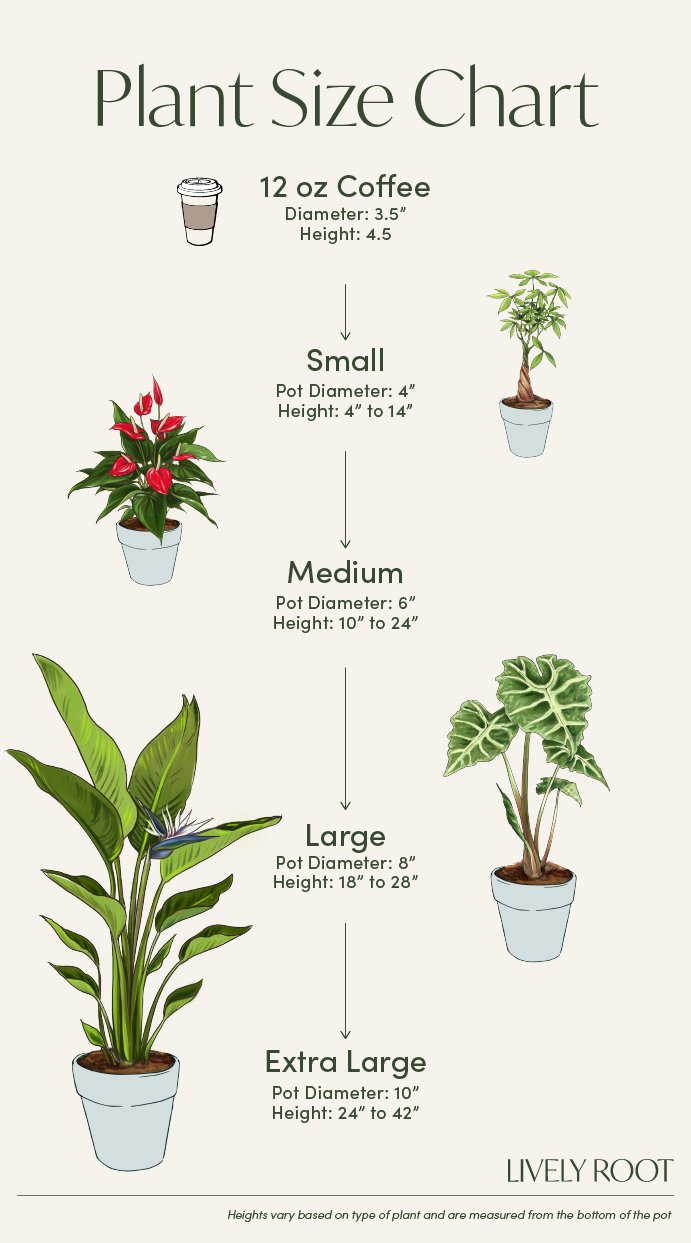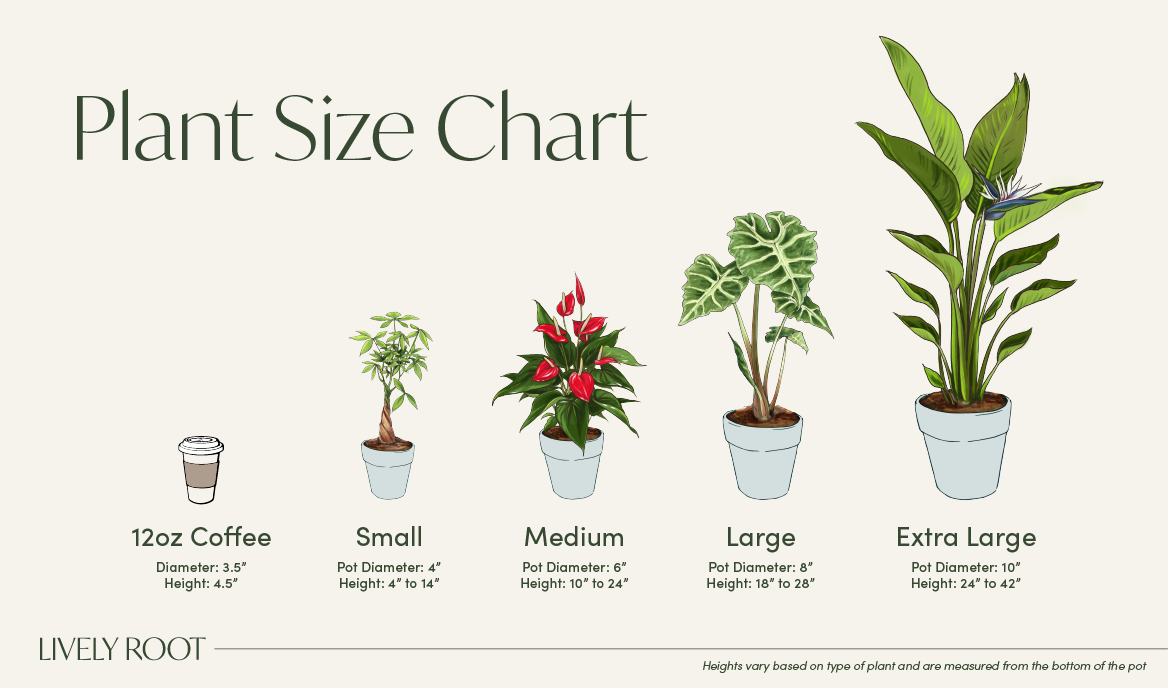

The Peacock Plant (Goeppertia makoyana syn. Calathea makoyana) can be considered a work of art from the celestial being that created orchids. It is a masterpiece and even gained notoriety with the Royal Horticultural Society as a must-have plant. Calathea Makoyana's stained glass appearance with green swipes of evergreen brushed on either side of the midrib against the silvery-green leaves will mesmerize you. You'll gasp when your Peacock Plant's leaves fold up in the evening to reveal its deep purple undersides. It's like having two different plants in one! Calathea Makoyan reaches 18" tall and does best in high-humidity areas.
Calathea Makoyana Care Guide & Presentation

This plant enjoys bright to medium indirect light.
Keep the soil slightly moist and water when the soil reaches a #5 on the moisture meter. Use filtered, bottled, or tap water sitting 24 hours to release the chemicals and water enough to discharge out of the drainage holes. Once the water is fully drained, replace it into the cache or decorative pot. Don't let the roots sit in standing water. During winter months, water less frequently but keep it humid around the plant.
Add up to 60% humidity by adding a pebble tray filled with water, grouping with other plants or using a humidifier. This plant has a thinner leaf, therefore needs more humidity around it to avoid drying out.
Guard your Prayer Plant against temperatures below 65°F to avoid foliage damage.
Outside: Grow in morning light, partial shade (4-6 hours) where nights are above 45°F. Indoors: The Prayer Plant prefers bright to medium, indirect light for at least six hours in a southern, eastern and western windows.
Fertilize monthly during its growing period. Use a high nitrogen liquid fertilizer at half strength to increase foliage health. Reduce during the fall and winter months while the plant is in its dormant phase. Flush the soil periodically to eliminate salts from fertilizing.
When receiving the plant, do not repot immediately but wait at least 6-12 months.
Repot in the spring, using a 2" wider pot. (Too large of a pot could cause the soil to dry slower, which is not helpful.) Use a well-draining indoor potting mix with perlite to help with drainage or an african violet potting mix.
Place a piece of screening at the bottom of the container over the drainage hole to secure the soil and allow it to drain. Add soil to the bottom to elevate the root ball. Lift the plant and release the roots against the existing planter. Use a clean knife or garden trowel to wedge between the pot and the soil to loosen.
Inspect the root ball. Notice if there are any dead or rotting roots and trim off with sterile pruners. If the plant is rootbound, cut through the roots to alleviate continued encircling.
Ensure the plant is sitting about 1" below the edge of the pot to avoid water spillage. Add more soil and backfill around the sides by tamping down. Fill up to the soil line but not over.
Water thoroughly, leaving the soil damp but not soggy. If settling occurs, add more soil.
Trim off any dead or damaged stems to keep energy moving to the healthy leaves. Shower the leaves using a watering can with filtered or rainwater to remove dust. Remove any debris on the soil and replenish soil if needed.
Indoors: Propagate and divide Prayer Plants in the early spring when emerging from dormancy.
Pull from the container and brush or wash away the soil carefully. Carefully divide and repot in a rich, indoor potting soil mix or African violet mix.
Use a container that has drainage and is deep enough for the roots to grow.
Set it in medium to bright, indirect sunlight while they are rooting. Enclose the new plantings in clear plastic bags, mist and keep them in medium light. Remove the plastic bag when the roots are established. You may observe some leaf changes as it acclimates to its new environment. It may suffer some transplant shock depending on how tight the roots were intertwined together. Trim off any declining leaves as it regains its energy and gets rooted into the soil over time. Check the moisture and humidity each day and add misting to keep the soil moist while the roots establish.
After 6-8 weeks, roots will begin to establish. You can tug onto the stem to ensure the roots are anchoring well. You can remove the clear plastic bag at this time but still maintain high humidity around the plant.
Peacock Plant: Overview
The Calathea Makoyana, also known as the Peacock Plant, is a striking member of the Prayer plant family (Marantaceae) native to Brazil. Its large, oval leaves are adorned with feather-like patterns in shades of deep green and light cream, resembling a peacock’s tail, giving the plant its common name. The undersides of the leaves are a rich purple, adding to their visual appeal, especially when the leaves fold up at night, a characteristic behavior of prayer plants.
This tropical evergreen thrives in USDA hardiness zones 10-11 but is typically grown indoors in other regions. The Peacock Plant can reach up to 2 feet in height and spread, making it a perfect plant for adding lush greenery to indoor spaces. It prefers indirect light, as direct sunlight can scorch its delicate leaves. Known for its relatively high humidity and moisture needs, it’s considered a moderate-care plant, ideal for plant enthusiasts who can provide the right environment.
Symbolically, the Peacock Plant is often associated with new beginnings and positivity, making it a meaningful addition to homes or offices. In addition, Calathea plants are also pet-friendly, making them a safe choice for households with cats and dogs. Other notable Calathea species include the Calathea Orbofolia, with its large, round leaves, and the Calathea Setosa, known as the Compact Star plant.
Peacock Plant: Benefits
- It has strong air-purifying properties. Hence, it improves indoor air quality.
- Safe for homes with pets, as it's non-toxic to cats and dogs
- Symbolizes new beginnings, positivity, and renewal
- Adds aesthetic value with its vibrant, patterned foliage
Peacock Plant: Care Guide
The Calathea Peacock Plant, also known as Calathea makoyana, is a relatively easy-care plant, ideal for indoor gardeners, who can provide a humid environment and indirect light for this tropical plant. Here's a comprehensive Calathea care guide:
Watering & Humidity
Peacock plants prefer consistently moist soil but avoid overwatering, as soggy soil can lead to root rot. Water the plant when the top inch of soil feels dry. High humidity is essential, so consider placing the plant in a bathroom or using a humidifier. Misting the leaves regularly will also help maintain humidity.
Light & Temperature
Place your Calathea in bright, indirect light. Direct sunlight can scorch the leaves, while too little light will cause the vibrant patterns to fade. Keep the plant in a room between 65-80°F (18-27°C) and avoid cold drafts or sudden temperature drops.
Soil & Repotting
Use a well-draining potting mix rich in organic matter, such as a blend of peat, perlite, and pine bark. Repot your Calathea every 1-2 years in the spring or when the roots outgrow the current pot to refresh the soil and provide more space for growth.
Feeding & Pruning
Feed your Peacock Plant every 4-6 weeks during the growing season (spring and summer) with a balanced, water-soluble fertilizer diluted to half-strength. Prune any yellow or damaged leaves to maintain the plant's appearance and health. Regular cleaning of the leaves with a damp cloth will help remove dust and prevent pests.
Peacock Plant: Propagation
Calathea propagation is relatively easy. To propagate your prayer plant, it’s best to divide it during repotting. Carefully separate the plant into smaller sections, ensuring each has healthy roots and leaves. Place the new plants in a spot with indirect light.
Common Issues & Troubleshooting
Watch for common leaf issues with your Calathea prayer plant, like leaf curling, which can indicate underwatering or low humidity. Brown leaf edges may signify dry air, while yellowing leaves could indicate overwatering. Treat the plant with insecticidal soap or neem oil if you notice pests like spider mites or aphids.
Peacock Plant: Placement, Companion & Alternative Plants
The Calathea Peacock Plant is a versatile and attractive indoor plant that thrives in specific environments and complements various decor styles. Here’s where and how it can be best utilized.
Best Locations & Uses
- The calming patterns on the leaves make it a perfect addition to a restful bedroom environment.
- As a non-toxic plant, it’s safe for homes with curious cats or dogs.
- It thrives in high-humidity environments, making it an excellent choice for bright bathrooms.
- Its symbolic association with new beginnings makes it a meaningful gift for special occasions.
- It can add a tropical flair to a shaded porch or patio in mild climates.
Companion Plants
The Peacock Plant pairs beautifully with other indoor plants that thrive in similar conditions.
- Peace Lily (Spathiphyllum.): Peace Lily is an elegant, easy-care plant that shares Calathea’s preference for low to medium light and high humidity.
- Golden Pothos (Epipremnum aureum): The popular Golden Pothos is a hardy, trailing plant that complements Calathea’s upright growth and thrives in similar low-light conditions.
- Japanese Bird’s Nest Fern (Asplenium antiquum): The Japanese Bird’s Nest Fern is a pet-friendly fern that adds a lush, tropical vibe and thrives in the same humid environment as the Calathea plant.
Alternative Plants
If you’re looking for pet-friendly alternatives with similar aesthetics and care needs, consider these options:
- Marantha Red Prayer Plant (Maranta leuconeura var. kerchoveana): With striking patterned leaves that require the same level of care as the Peacock Plant, the Maranta Prayer Plant is a beautiful alternative.
- Calathea Freddie (Calathea concinna): Calathea Freddie is a gorgeous, easy-care plant with light green leaves and dark green stripes, ideal for low-light environments.
- Calathea Rattlesnake (Calathea lancifolia): With its long, wavy leaves and striking patterns, the Calathea Rattlesnake is perfect for those who want a unique and rare plant that is equally pet-friendly.
Order Your Peacock Plant From Lively Root Now!
Bring home the stunning Calathea Makoyana from Lively Root today and elevate your indoor space with its vibrant, air-purifying beauty!


















































